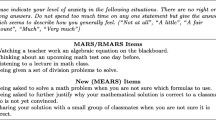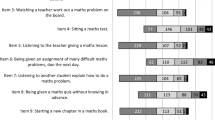Abstract
The objective of the present study was to examine the relationship between mathematics anxiety and the procedural and conceptual knowledge of fractions in prospective teachers. Thirty-two preservice teachers enrolled in an elementary mathematics methods course were administered the Revised Mathematics Anxiety Rating Scale (RMARS, Baloğlu, 2002). Procedural and conceptual knowledge of fractions was assessed with a validated paper and pencil test (Saxe, Gearhart, & Nasir, 2001) and with four additional problems created by the researchers. Results indicated that as mathematics anxiety scores increased, scores on the validated measure of procedural knowledge of fractions decreased. The same relationship was found between the RMARS and the validated measure of conceptual knowledge. The findings provide some insight on the cognitive and pedagogical factors associated with mathematics anxiety in the preservice teacher population, underscoring the importance of facilitating their proficiency in both mathematical procedures and concepts.
Similar content being viewed by others
References
Ashcraft, M. H. (2002). Math anxiety: Personal, educational, and cognitive consequences.Current Directions in Psychological Science, 11(5), 181–185.
Ashcraft, M. H., & Kirk, E. P. (2001). The relationships among working memory, math anxiety, and performance.Journal of Experimental Psychology: General, 130(2), 224–237.
Ashcraft, M. H., Kirk, E. P., & Hopko, D. (1998). On the cognitive consequences of mathematics anxiety. In C. Donlan (Ed.),The development of mathematical skills (pp. 175–196). Hove, England: Psychology Press.
Ball, D. L. (1990). Prospective elementary and secondary teachers’ understanding of division.Journal for Research in Mathematics Education, 21(2), 132–144.
Ball, D. L., & Bass, H. (2000). Interweaving content and pedagogy in teaching and learning to teach: Knowing and using mathematics. In J. Boaler (Ed.),Multiple perspectives on mathematics teaching and learning (pp. 83–104). Westport, CT: Ablex.
Ball, D. L., Hill, H. C., & Bass, H. (2005). Knowing mathematics for teaching: Who knows mathematics well enough to teach third grade, and how can we decide?American Educator, 29(3), 14–46.
Ball, D. L., & Rowan, B. (2004). Introduction: Measuring instruction.The Elementary School Journal, 105(1), 3–10.
Ball, D. L., Thames, M. H., & Phelps, G. (2008). Content knowledge for teaching: What makes it special?”Journal of Teacher Education, 59(5), 389–407.
Baloğlu, M. (2002). Construct and concurrent validity and internal consistency, split-half, and parallel-model reliability of the revised mathematics rating scale.Dissertation Abstracts International, 63, 6-B. (UMI No. 3058162)
Baloğlu, M., & Koçak, R. (2006). A multivariate investigation of the differences in mathematics anxiety.Personality and Individual Differences, 40, 1325–1335.
Battista, M. T. (1986). The relationship of mathematics anxiety and mathematical knowledge to the learning of mathematical pedagogy by preservice elementary teachers.School Science and Mathematics, 86(1), 10–19.
Behr, M. J., Lesh, R., Post, T. R., & Silver, E. (1983). Rational-number concepts. In R. Lesh & M. Landau (Eds.),Acquisitions of mathematics concepts and processes (pp. 91–126). New York: Academic Press.
Bessant, K. C. (1995). Factors associated with types of mathematics anxiety in college students.Journal for Research in Mathematics Education, 26(4), 327–345.
Bowd, A. D., & Brady, P. H. (2003). Gender differences in mathematics anxiety among preservice teachers and perceptions of their elementary and secondary school experience with mathematics.Alberta Journal of Educational Research, 49(1), 24–36.
Brady, P., & Bowd, A. (2005). Mathematics anxiety, prior experience and confidence to teach mathematics among pre-service education students.Teachers and Teaching: Theory and Practice, 11(1), 37–46.
Bransford, J. D., Brown, A. L., & Cocking, R. R. (Eds.). (2000).How people learn: Brain, mind, experience, and school: Expanded edition. Washington, DC: National Academy Press.
Cohen, J. (1960). A coefficient of agreement for nominal scales.Educational and Psychological Measurement, 20, 37–46.
Cohen, J. (1988).Statistical power analysis (2nd ed.). Hillsdale, NJ: Erlbaum.
Conrad, K. S., & Tracy, D. M. (1992).Lowering preservice teachers’ math anxiety through an experience-based mathematics methods course. (ERIC Document Reproductions Service No. ED355099)
Cooper, S. E., & Robinson, D. A. G. (1991). The relationship of mathematics selfefficacy beliefs to mathematics anxiety and performance.Measurement and Evaluation in Counseling and Development, 24(1), 4–13.
D’Ambrosio, B. S., & Mewborn, D. S. (1994). Children’s construction of fractions and their implications for classroom instruction.Journal of Research in Childhood Education, 8(2), 150–161.
Eysenck, M. W., & Calvo, M. G. (1992). Anxiety and performance: The processing efficiency theory.Cognition and Emotion, 6, 409–434.
Faust, M. W., Ashcraft, M. H., & Fleck, D. E. (1996). Mathematics anxiety effects in simple and complex addition.Mathematical Cognition, 2(1), 25–62.
Harper, N. W., & Daane, C. J. (1998). Causes and reduction of math anxiety in preservice elementary teachers.Action in Teacher Education, 19(4), 29–38.
Hembree, R. (1990). The nature, effects, and relief of mathematics anxiety.Journal for Research in Mathematics Education, 21(1), 33–46.
Hiebert, J., Carpenter, T. R., Fennema, E., Fuson, K. C., Wearne, D., Murray, H., et al. (1997).Making sense: Teaching and learning mathematics with understanding. Portsmouth, NH: Heinemann.
Hiebert, J., & Lefevre, P. (1986). Conceptual and procedural knowledge in mathematics: An introductory analysis. In J. Hiebert (Ed.),Conceptual and procedural knowledge: The case of mathematics (pp. 1–27). Hillsdale, NJ: Erlbaum.
Hiebert, J., & Wearne, D. (1996). Instruction, understanding, and skill in multidigit addition and subtraction.Cognition and Instruction, 14(3), 251–283.
Hill, H. C., Rowan, B., & Ball, D. L. (2005). Effects of teachers’ mathematical knowledge for teaching on student achievement.American Educational Research Journal, 42(2), 371–406.
Hopko, D. R., Ashcraft, M. H., Gute, J., Ruggiero, K. J., & Lewis, C. (1998). Mathematics anxiety and working memory: Support for the existence of a deficient inhibition mechanism.Journal of Anxiety Disorders, 12(4), 343–355.
Kazelskis, R. (1998). Some dimensions of mathematics anxiety: A factor analysis across instruments.Educational and Psychological Measurement, 58(4), 623–633.
Kelly, W. P., & Tomhave, W. K. (1985). A study of math anxiety/math avoidance in preservice elementary teachers.Arithmetic Teacher, 32(5), 51–53.
Kilpatrick, J., Swafford, J., & Findell, B. (2001).Adding it up: Helping children learn mathematics. Washington: National Academy Press.
Lefevre, J., Kulak, A. G., & Heymans, S. L. (1992). Factors influencing the selection of university majors varying in mathematical content.Canadian Journal of Behavioural Science, 23(4), 276–289.
Ma, L. (1999).Knowing and teaching elementary mathematics: Teachers’ understanding of fundamental mathematics in China and the United States. Mahwah, NJ: Erlbaum.
Ma, X. (1999). A meta-analysis of the relationship between anxiety toward mathematics and achievement in mathematics.Journal for Research in Mathematics Education, 30, 520–540.
Ma, X., & Xu, J. (2004). The causal ordering of mathematics anxiety and mathematics achievement: A longitudinal panel analysis.Journal of Adolescence, 27, 165–179.
McLeod, D. B. (1989). The role of affect in mathematical problem solving. In D. B. McLeod and V. M. Adams (Eds.),Affect and mathematical problem solving: A new perspective (pp. 20–36). NY: Springer-Verlag.
McLeod, D. B. (1994). Research on affect and mathematics learning in the JRME: 1970 to the present.Journal for Research in Mathematics Education, 25th Anniversary Special Issue, 25(6), 637–647.
Meece, J. L., Wigfield, A., & Eccles, J. S. (1990). Predictors of math anxiety and its influence on young adolescents’ course enrolment intentions and performance in mathematics.Journal of Educational Psychology, 82(1), 60–70.
Miller, H., & Bichsel, J. (2004). Anxiety, working memory, gender, and math performance.Personality and Individual Differences, 37, 591–606.
National Commission on Teaching and America’s Future. (1997).Doing what matters most: Investing in quality teaching. New York: Author.
National Council of Teachers of Mathematics. (2000).Principles and standards for school mathematics. Reston, VA: Author.
Osana, H. P., Lacroix, G. L., Rayner, V., Pitsolantis, N., & Ing, W. (2008).The role of teachers’ knowledge and classroom practices in the mathematical development of first-grade students. Poster presented at the Banff International Conference on Behavioural Science, Banff, Alberta, Canada.
Osana, H. P., Lacroix, G. L., Tucker, B. J., & Desrosiers, C. (2006). The role of content knowledge and problem features on preservice teachers’ appraisal of elementary mathematical tasks.Journal of Mathematics Teacher Education, 9(4), 347–380.
Pellegrino, J. W., Chudowsky, N., & Glaser, R. (2001).Knowing what students know: The science and design of educational assessment. Washington, DC: National Academy Press.
Perkins, D. N. (1999). The many faces of constructivism.Educational Leadership, 57(3), 6–11.
Richardson, F. C., & Suinn, R. M. (1972). The Mathematics Anxiety Rating Scale: Psychometric data.Journal of Counseling Psychology, 19(6), 551–554.
Saxe, G. B., Gearhart, M., & Nasir, N. S. (2001). Enhancing students’ understanding of mathematics: A study of three contrasting approaches to professional support.Journal of Mathematics Teacher Education, 4, 55–79.
Sloan, T., Daane, C. J., & Giesen, J. (2002). Mathematics anxiety and learning styles: What is the relationship in elementary preservice teachers?School Science and Mathematics, 102(2), 84–87.
Sloan, T. R., Vinson, B., Haynes, J., & Gresham, R. (1997, November).A comparison of pre-and post-levels of mathematics anxiety among preservice teacher candidates enrolled in a mathematics methods course. Paper presented at the annual meeting of the MidSouth Educational Research Association, Memphis, TN.
Star, J. R. (2005). Reconceptualizing procedural knowledge.Journal for Research in Mathematics Education, 36(5), 404–411.
Tabachnick, B. G., & Fidell, L. S. (2001).Using multivariate statistics (4th ed.). Needham Heights, MA: Allyn & Bacon.
Tirosh, D. (2000). Enhancing prospective teachers’ knowledge of children’s conceptions: The case of division of fractions.Journal for Research in Mathematics Education, 31(1), 5–25.
Tirosh, D., Fischbein, E., Graeber, A. O., & Wilson, J. W. (1998). Prospective elementary teachers’ conceptions of rational number. Retrieved October 6, 2006, from http://jwilson.coe.uga.edu/Texts.Folder/Tirosh/Pros.El.Tchrs.html
Trice, A. D., & Ogden, E. D. (1986). Correlates of mathematics anxiety in first-year elementary school teachers.Educational Research Quarterly, 11(3), 2–4.
Trujillo, K. M., & Hadfield, O. D. (1999). Tracing the roots of mathematics anxiety through in-depth interviews with preservice teachers.College Student Journal, 33(2), 219–232.
Turner, J. C., Midgley, C., Meyer, D. K., Gheen, M., Anderman, E. M., Kang, Y., et al. (2002). The classroom environment and students’ reports of avoidance strategies in mathematics: A multimethod study.Journal of Educational Psychology, 94(1), 88–106.
Uusimaki, L., & Nason, R. (2004). Causes underlying pre-service teachers’ negative beliefs and anxieties about mathematics. In M. J. Høines & A. B. Fuglestad (Eds.),Proceedings of the 28th conference of the International Group for the Psychology of Mathematics Education (Vol. 4, pp. 369–376). Bergen, Norway: Bergen University.
Vinson, B. (2001). A comparison of preservice teachers’ mathematics anxiety before and after a methods class emphasizing manipulatives.Early Childhood Education Journal, 29(2), 89–94.
Widmer, C. C., & Chavez, A. (1982). Math anxiety and elementary school teachers.Education, 102(3), 272–276.
Wigfield, A., & Meece, J. L. (1988). Math anxiety in elementary and secondary school students.Journal of Educational Psychology, 80(2), 210–216.
Wilson, S., & Thornton, S. (2005).’I am really not alone in this anxiety’: Bibliotherapy and pre-service primary teachers’ self-image as mathematicians. Paper presented at the 28th Annual Conference of the Mathematics Education Research Group of Australasia, Melbourne, Australia.
Wood, E. F. (1988). Math anxiety and elementary teachers: What does research tell us?For the Learning of Mathematics, 8(1), 8–13.
Wu, H. (1997).On the education of mathematics teachers. Retrieved from University of California, Berkeley Web site:http://www.math.berkeley.edu/~wu/
Wu, H. (2001, Summer). How to prepare students for algebra.American Educator, 1–7.
Zan, R., Brown, L., Evans, J., & Hannula, M. S. (2006). Affect in mathematics education: An introduction.Educational Studies in Mathematics, 63(2), 113–121.
Author information
Authors and Affiliations
Rights and permissions
About this article
Cite this article
Rayner, V., Pitsolantis, N. & Osana, H. Mathematics anxiety in preservice teachers: Its relationship to their conceptual and procedural knowledge of fractions. Math Ed Res J 21, 60–85 (2009). https://doi.org/10.1007/BF03217553
Issue Date:
DOI: https://doi.org/10.1007/BF03217553




